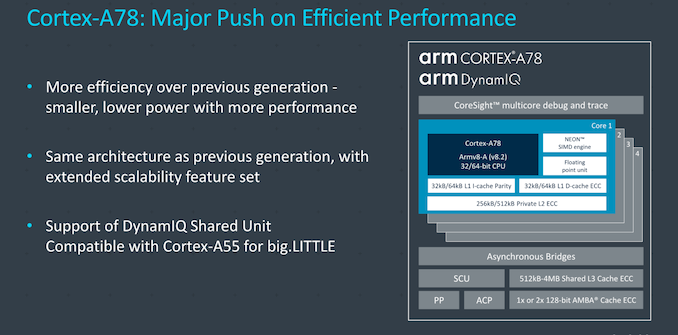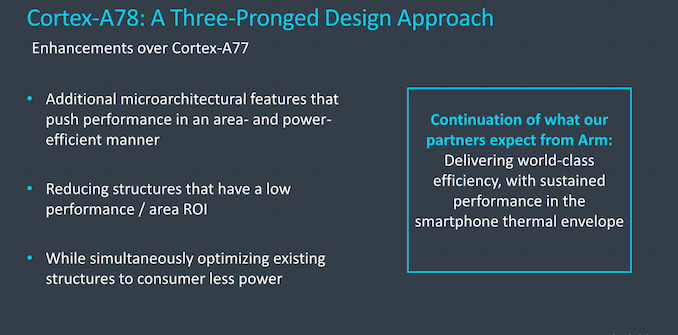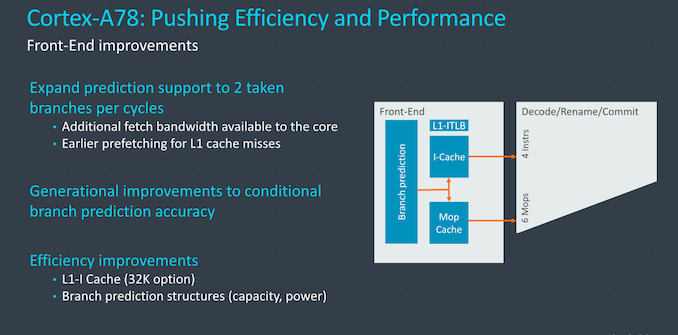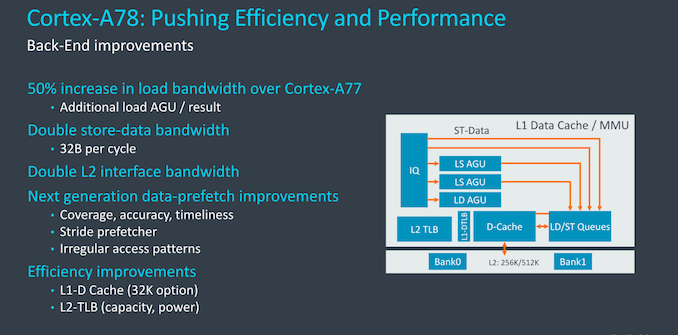Arm's New Cortex-A78 and Cortex-X1 Microarchitectures: An Efficiency and Performance Divergence
by Andrei Frumusanu on May 26, 2020 9:00 AM EST- Posted in
- SoCs
- CPUs
- Arm
- Smartphones
- Mobile
- GPUs
- Cortex
- Cortex A78
- Cortex X1
- Mali G78
The Cortex-A78 Micro-architecture: PPA Focused
The new Cortex-A78 had been on Arm’s roadmaps for a few years now, and we have been expecting the design to represent the smallest generational microarchitectural jump in Arm’s new Austin family. As the third iteration of Arm's Austin core designs, A78 follows the sizable 25-30% IPC improvements that Arm delivered on the Cortex-A76 and A77, which is to say that Arm has already picked a lot of the low-hanging fruit in refining their Austin core.
As the new A78 now finds itself part of a sibling pairing along side the higher performance X1 CPU, we naturally see the biggest focus of this particular microarchitecture being on improving the PPA of the design. Arm’s goals were reasonable performance improvements, balanced with reduced power usage and maintaining or reducing the area of the core.
It’s still an Arm v8.2 CPU, sharing ISA compatibility with the Cortex-A55 CPU for which it is meant to be paired with in a DynamIQ cluster. We see similar scaling possibilities here, with up to 4 cores per DSU, with an L3 cache scaling up to 4MB in Arm’s projected average target designs.
Microarchitectural improvements of the core are found throughout the design. On the front-end, the biggest change has been on the part of the branch predictor, which now is able to process up to two taken branches per cycle. Last year, the Cortex-A77 had introduced as secondary branch execution unit in the back-end, however the actual branch unit on the front-end still only resolved a single branch per cycle.
The A78 is now able to concurrently resolve two predictions per cycle, vastly increasing the throughput on this part of the core and better able to recover from branch mispredictions and resulting pipeline bubbles further downstream in the core. Arm claims their microarchitecture is very branch prediction driven so the improvements here add a lot to the generational improvements of the core. Naturally, the branch predictors themselves have also been improved in terms of their accuracy, which is an ongoing effort with every new generation.
Arm focused on a slew of different aspects of the front-end to improve power efficiency. On the part of the L1I cache, we're now seeing the company offer a 32KB implementation option for vendors, allowing customers to reduce area of the core for a small hit on performance, but with gains in efficiency. Other changes were done to some structures of the branch predictors, where the company downsized some of the low return-on-investment blocks which had a larger cost on area and power, but didn’t have an as large impact on performance.
The Mop cache on the Cortex-A78 remained the same as on the A77, housing up to 1500 already decoded macro-ops. The bandwidth from the front-end to the mid-core is the same as on the A77, with an up to 4-wide instruction decoder and fetching up to 6 instructions from the macro-op cache to the rename stage, bypassing the decoder.
In the mid-core and execution pipelines, most of the work was done in regards to improving the area and power efficiency of the design. We’re now seeing more cases of instruction fusions taking place, which helps not only performance of the core, but also power efficiency as it now uses up less resources for the same amount of work, using less energy.
The issue queues have also seen quite larger changes in their designs. Arm explains that in any OOO-core these are quite power-hungry features, and the designers have made some good power efficiency improvements in these structures, although not detailing any specifics of the changes.
Register renaming structures and register files have also been optimized for efficiency, sometimes seeing a reduction of their sizes. The register files in particular have seen a redesign in the density of the entries they’re able to house, packing in more data in the same amount of space, enabling the designers to reduce the structures’ overall size without reducing their capabilities or performance.
On the re-order-buffer side, although the capacity remains the same at 160 entries, the new A78 improves power efficiency and the density of instructions that can be packed into the buffer, increasing the instructions per unit area of the structure.
Arm has also fine-tuned the out-of-order window size of the A78, actually reducing it in comparison to the A77. The explanation here is that larger window sizes generally do not deliver a good return on investment when scaling up in size, and the goal of the A78 is to maximize efficiency. It’s to be noted that the OOO-window here not solely refers to the ROB which has remained the same size, Arm here employs different buffers, queues, and structures which enable OOO operation, and it’s likely in these blocks where we’re seeing a reduction in capacity.
On the diagram, here we see Arm slightly changing its descriptions on the dispatch stage, disclosing a dispatch bandwidth of 6 macro-ops (Mops) per cycle, whereas last year the company had described the A77 as dispatching 10 µops. The apples-to-apples comparison here is that the new A78 increases the dispatch bandwidth to 12 µops per cycle on the dispatch end, allowing for a wider execution core which houses some new capabilities.
On the integer execution side, the only big addition has been the upgrade of one of the ALUs to a more complex pipeline which now also handles multiplications, essentially doubling the integer MUL bandwidth of the core.
The rest of the execution units have seen very little to no changes this generation, and are pretty much in line with what we’ve already seen in the Cortex-A77. It’s only next year where we expect to see a bigger change in the execution units of Arm’s cores.
On the back-end of the core and the memory subsystem, we actually find some larger changes for performance improvements. The first big change is the addition of a new load AGU which complements the two-existing load/store AGUs. This doesn’t change the store operations executed per cycle, but gives the core a 50% increase in load bandwidth.
The interface bandwidth from the LD/ST queues to the L1D cache has been doubled from 16 bytes per cycle to 32 bytes per cycle, and the core’s interfaces to the L2 has also been doubled up in terms of both its read and write bandwidth.
Arm seemingly already has some of the most advanced prefetchers in the industry, and here they claim the A78 further improves the designs both in terms of their memory area coverage, accuracy and timeliness. Timeliness here refers to their quick latching on onto emerging patterns and bringing in the data into the lower caches as fast as possible. You also don’t watch the prefetchers to kick in too early or too late, such as needlessly prefetching data that’s not going to be used for some time.
Much like the L1I cache, the A78 now also offers an 32KB L1D option that gives vendors the choice to configure a smaller core setup. The L2 TLB has also been reduced from 1280 to 1024 pages – this essentially improves the power efficiency of the structure whilst still retaining enough entries to allow for complete coverage of a 4MB L3 cache, still minimizing access latency in that regard.
Overall, the Cortex-A78’s microarchitectural disclosures might sound surprising if the core were to be presented in a vacuum, as we’re seeing quite a lot of mentions of reduced structure sizes and overall compromises being made in order to maximize energy efficiency. Naturally this makes sense given that the Cortex-X1 focuses on performance…















192 Comments
View All Comments
Drake H. - Tuesday, May 26, 2020 - link
Honestly, who cares about that? This extra power is useless. Playing on mobile device is uncomfortable and bad for eye health. They should convert priority into maximum efficiency only.The critical point that needs to evolve in smartphones is the battery and nobody talks about. Where are the graphene batteries samsung promised? I miss having a cell phone that lasts a week without charging. :(
syxbit - Tuesday, May 26, 2020 - link
Extra power is never useless. Sure if you just browse facebook. But iPads and Android tablets are trying to replace laptops. The A13 can probably replace a laptop. No Qualcomm chip can do that as well.I suspect when Apple replaces their laptop intel chips with their Arm chips, they'll be faster, and better battery life. But when Microsoft tries to do it with QCOMM, they're much worse
skavi - Tuesday, May 26, 2020 - link
Android tablets are dead in the high end. Would like to see some X1 cores in a future Surface tho.Drake H. - Tuesday, May 26, 2020 - link
Nah, there is no ARM CPU that can replace a regular x86 CPU for gaming or work, and it won't exist at any time soon. You don't reverse millions of software and years of optimization overnight.FunBunny2 - Tuesday, May 26, 2020 - link
"You don't reverse millions of software and years of optimization overnight."cross-compile is old news. any C/C++ compiler can do that. OTOH, all those system calls are the major issue.
vladx - Tuesday, May 26, 2020 - link
Cross-compiling doesn't mean your software will run at same performance on everything, for that to happen you still need to implement architecture-specific optimizations and even so there's still no guarantees.serendip - Wednesday, May 27, 2020 - link
A fast ARM chip could brute force x86-32 code translation so it was fast enough. The SQ1 in the Surface Pro X can run x86-32 code without it being snail slow like on older SD850 devices. An X1-based chip could probably do x86-64 translation (coming next year according to Microsoft) at 8th gen i5 levels, and it would fly when running ARM native code.Drake H. - Wednesday, May 27, 2020 - link
By this logic it seems that anyone could port the x86 recompiler from pcsx2 to ARM with a few clicks. Optimizing software for ARM would take a lot of time and money, not to mention that some of these software has no source code available.iphonebestgamephone - Wednesday, May 27, 2020 - link
Not on android or windows, but on a console its pretty good for gaming, as proven by the switch?soresu - Wednesday, May 27, 2020 - link
How can you be disappointed?It's not like there is a direct comparison, often with high end apps and games there is a serious lag between it being available on iOS and it becoming available on Android, sometimes it never comes at all.
Though the openness of Android means we get some things easily that iOS device owners have to jump through hoops for, namely console emulators.
What's the use having all that power in the Apple Axx SoC's when you are restricted in your freedom to do with it as you wish? All things considered I'll take a performance hit for that freedom any day of the week.